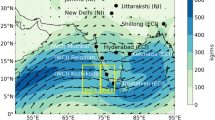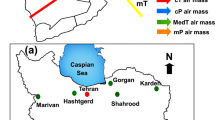Abstract
The stable water isotope ratio in precipitation is a useful tracer of atmospheric circulation. Such observations, however, are very limited in space and time. To solve this problem, many isotope-enabled general circulation models (GCMs) are used to help the interpretation of isotope proxies. In this paper, several isotope-enabled GCMs released by the second Stable Water Isotope Intercomparison Group (SWING2) were selected to assess the spatial pattern of deuterium (δD) and the deuterium excess (d) of precipitation in China. The isotopic data of the Global Network of Isotopes in Precipitation (GNIP) and the Chinese Network of Isotopes in Precipitation (CHNIP) were also applied to verify the simulations. The results indicate that these models accurately simulate the spatial characteristics of δD and d of precipitation in China. The correlation between the observations and simulations for LMDZ is the highest among these models, while the root-mean-square (RMS) and standard deviation are not perfect. In addition, LMDZ is worse than other models in capturing the low signal in certain regions, such as CAM, GISS_E, and MIROC. For the monthly variation, most SWING2 models underestimate δD of the precipitation but overestimate the value of d, except for isoGSM. The simulated monthly variation of the water isotopes from SWING2 models is in general similar to the observations, and the trend corresponds to the monthly variation in the Northern Hemisphere. Moreover, all models are good at illustrating the temperature and precipitation amount effects, while they exhibit varying skills in interpreting the altitude and continental effects.









Similar content being viewed by others
References
AGU (1995) U.S. National report to IUGG 1991–1994: contributions in atmospheric sciences. Boulder, Colorado, 7.
Araguás-Araguás L, Froehlich K, Rozanski K (2000) Deuterium and oxygen-18 isotope composition of precipitation and atmospheric moisture. Hydrol Process, 14(8): 1341–1355. doi:10.1002/1099-1085(20000615)
Cai Z, Tian L (2016) Atmospheric controls on seasonal and interannual variations in the precipitation isotope in the east Asian monsoon region. J Climate 29(4):1339–1352
Conroy JL, Cobb KM, Noone D (2013) Comparison of precipitation isotope variability across the tropical Pacific in observation and SWING2 model simulations. J Geophys Res Atmos 118(11):5867–5892
Dansgaard W (1964) Stable isotopes in precipitation. Tellus B 16:436–468
Dincer T (1968) The use of oxygen 18 and deuterium concentration in the water balance of lakes. Water Resour Res 4(6):1289–1305
Gat JR, Mazor E, Tzur Y (1969) The stable isotope composition of mineral waters in the Jordan Rift Valley, Israel. J Hydrol 7(3):334–352
Gryazin V, Risi C, Jouzel J, Kurita N, Worden J, Frankenberg C, Bastrikov V, Gribanov K, Stukova O (2014) To what extent could water isotopic measurements help us understand model biases in the water cycle over western Siberia. Atmos Chem Phys 14(18): 9807-9830
Gu W (2011) Isotope hydrology. Science Press, Beijing
Haese B, Werner M, Lohmann G (2013) Stable water isotopes in the coupled atmosphere-land surface model ECHAM5-JSBACH. Geosci Model Dev 6:1463–1480
Hoffmann G, Werner M, Heimann M (1998) Water isotope module of the ECHAM atmospheric general circulation model: a study on timescales from days to several years. J Geophys Res Atmos 103(D14):16871–16896
Kurita N, Noone D, Risi C, Schmidt GA, Yamada H, Yoneyama K (2011) Intraseasonal isotopic variation associated with the Madden-Julian oscillation. J Geophys Res Atmos 116(D24):D24101. doi:10.1029/2010JD015209
Lee J-E, Fung I, DePaolo DJ, Henning CC (2007) Analysis of the global distribution of water isotopes using the NCAR atmospheric general circulation model. J Geophys Res Atmos 112(D16). doi:10.1029/2006JD007657
Li J, Pang Z, Kong Y, Huang TM, Zhou MZ (2014) Contrasting seasonal distribution of stable isotopes and deuterium excess in precipitation over China. Fresen Environ Bull 23(9): 2078-2085.
Liu J, Song X, Yuan G, Sun X, Yang L (2014) Stable isotopic compositions of precipitation in China. Tellus B 66:22567. doi:10.3402/tellusb.v66.22567
Pfahl S, Sodemann H (2014) What controls deuterium excess in global precipitation? Clim Past 10(2):771–781
Risi C, Bony S, Vimeux F, Jouzel J (2010) Water-stable isotopes in the LMDZ4 general circulation model: model evaluation for present-day and past climates and applications to climatic interpretations of tropical isotopic records. J Geophys Res Atmos 115(D12):D12118. doi:10.1029/2009JD013255
Risi C, Noone D, Worden J, Frankenberg C, Stiller G, Kiefer M, Funke B, Walker K, Bernath P, Schneider M, Bony S, Lee J, Brown D, Sturm C (2012a) Process—evaluation of tropospheric humidity simulated by general circulation models using water vapor isotopic observations: 2. Using isotopic diagnostics to understand the mid and upper tropospheric moist bias in the tropics and subtropics. J Geophys Res Atmos 117(D5):D05304. doi:10.1029/2011JD016623
Risi C, Noone D, Worden J, Frankenberg C, Stiller G, Kiefer M, Funke B, Walker K, Bernath P, Schneider M, Wunch D, Vanessa S, Deutscher N, Griffith D, Wennberg P, Strong K, Smale D, Mahieu E, Barthlott S, Hase F, García O, Notholt J, Warneke T, Toon G, Sayres D, Bony S, Lee J, Brown D, Uemura R, Sturm C (2012b) Process—evaluation of tropospheric humidity simulated by general circulation models using water vapor isotopologues: 1. Comparison between models and observations. J Geophys Res Atmos 117(D5):D05303. doi:10.1029/2011JD016621
Schmidt GA, LeGrande AN, Hoffmann G (2007) Water isotope expressions of intrinsic and forced variability in a coupled ocean-atmosphere model. J Geophys Res Atmos 112(D10):D10103. doi:10.1029/2006JD007781
Schotterer U, Oldfield F, Fröhlich K (1996) Global network for isotopes in precipitation. Bern, Switzerland, pp. 15–26
Song X, Liu J, Sun X, Yuan G, Liu X, Wang S, Hou S (2007) Establishment of Chinese network of isotopes in precipitation (CHNIP) based on CERN. Adv Earth Sci 22(7):738–747
Sturm C, Zhang Q, Noone D (2010) An introduction to stable water isotopes in climate models: benefits of forward proxy modeling for paleoclimatology. Clim Past 6(1):115–129
Taylor KE (2001) Summarizing multiple aspects of model performance in a single diagram. J Geophys Res 106(D7):7183–7192
Tian L, Yao T, MacClune K, White JWC, Schilla A, Vaughn B, Ichiyanagi K (2007) Stable isotopic variations in West China: a consideration of moisture sources. J Geophys Res Atmos 112(D10):D10112. doi:10.1029/2006JD007718
Tindall JC, Valdes PJ, Sime LC (2009) Stable water isotopes in HadCM3: isotopic signature of el Nino southern oscillation and the tropical amount effect. J Geophys Res Atmos 114(D4):D04111. doi:10.1029/2008JD010825
Wang S, Zhang M, Chen F, Che Y, Du M, Liu Y (2015) Comparison of GCM-simulated isotopic compositions of precipitation in arid Central Asia. J Geogr Sci 25(7):771–783
Worden J, Noone D, Bowman K, Beer R, Eldering A, Fisher B, Worden H (2007) Importance of rain evaporation and continental convection in the tropical water cycle. Nature 445(7127):528–532
Xi X (2014) A review of water isotopes in Atmospheric General Circulation Models: Recent advances and future prospects. International Journal of Atmospheric Sciences 2014. doi: 10.1155/2014/250920
Yoshimura K, Kanamitsu M, Noone D, Oki T (2008) Historical isotope simulation using reanalysis atmospheric data. J Geophys Res Atmos 113(D19):D19108. doi:10.1029/2008JD010074
Zhang M, Wang S (2016) A review of precipitation isotope studies in China: basic pattern and hydrological process. J Geogr Sci 26(7):921–938
Zhang X, Liu J, Tian L, Yao T (2004) Variations of δ 18O in precipitation along vapor transport paths over Asia. Acta Geogr Sinica 59(5):699–708
Zhang X, Sun Z, Guan H, Zhang X, Wu H, Huang Y (2011) GCM simulation of stable water isotopes in water cycle and intercomparisons over East Asia. J Glaciol Geocryol 33(6):1274–1285
Zhang X, Sun Z, Guan H, Zhang X, Wu H, Huang Y (2012) GCM simulation of stable isotopes in the water cycle in comparison with GNIP observation over East Asia. Acta Meteorol Sin 26: 420-437.
Acknowledgments
This work was supported by the National Natural Science Foundation of China (no. 41161012 and no. 41461003) and the National Basic Research Program of China (no. 2013CBA01801). The authors thank Stable Water Isotope Intercomparison Group, Phase 2 (SWING2) for providing the data (http://www.giss.nasa.gov/projects/swing2).
Author information
Authors and Affiliations
Corresponding author
Rights and permissions
About this article
Cite this article
Che, Y., Zhang, M., Wang, S. et al. Stable water isotopes of precipitation in China simulated by SWING2 models. Arab J Geosci 9, 732 (2016). https://doi.org/10.1007/s12517-016-2755-5
Received:
Accepted:
Published:
DOI: https://doi.org/10.1007/s12517-016-2755-5




